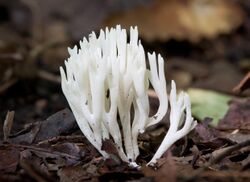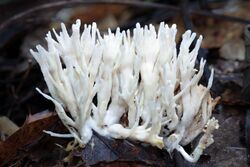Biology:Ramariopsis kunzei
| Ramariopsis kunzei | |
|---|---|

| |
| Scientific classification | |
| Domain: | Eukaryota |
| Kingdom: | Fungi |
| Division: | Basidiomycota |
| Class: | Agaricomycetes |
| Order: | Agaricales |
| Family: | Clavariaceae |
| Genus: | Ramariopsis |
| Species: | R. kunzei
|
| Binomial name | |
| Ramariopsis kunzei (Fr.) Corner (1950)
| |
| Synonyms[1] | |
|
Species synonymy
| |
| Ramariopsis kunzei | |
|---|---|
| Mycological characteristics | |
| smooth hymenium | |
| no distinct cap | |
| hymenium attachment is irregular or not applicable | |
| spore print is white | |
| ecology is mycorrhizal | |
| edibility: edible | |
Ramariopsis kunzei is an edible species of coral fungi in the family Clavariaceae, and the type species of the genus Ramariopsis. It is commonly known as white coral because of the branched structure of the fruit bodies that resemble marine coral. The fruit bodies are up to 5 cm (2.0 in) tall by 4 cm (1.6 in) wide, with numerous branches originating from a short rudimentary stem. The branches are one to two millimeters thick, smooth, and white, sometimes with yellowish tips in age. Ramariopsis kunzei has a widespread distribution, and is found in North America, Europe, Asia, and Australia.
Taxonomy and phylogeny
The species was first described as Clavaria kunzei by pioneer mycologist Elias Magnus Fries in 1821.[2] E.J.H. Corner transferred the species to Ramariopsis in 1950, and made it the type species.[3] In general, coral fungi often have extensive taxonomic histories, as mycologists have not agreed on the best way to classify them. In addition to Clavaria and Ramariopsis, the R. kunzei has been placed in the genera Ramaria by Lucien Quélet in 1888, and Clavulinopsis by Walter Jülich in 1985. According to the taxonomic database MycoBank,[1] the species has acquired a sizable list of synonyms, listed in the taxobox. It is commonly known as white coral because of the branched structure of the fruit bodies that resemble marine coral.[4]
A phylogenetic analysis of clavarioid fungi concluded that R. kunzei is in a phylogenetic lineage together with several Clavulinopsis species (including C. sulcata, C. helvola and C. fusiformis), and that this clade (the ramariopsis clade) is nested within a group of species representing the family Clavariaceae.[5]
Description
The fruit bodies of Ramariopsis kunzei are white to whitish-yellow in color, and are highly branched structures resembling coral; the dimensions are typically up to 8 cm (3.1 in) tall and 6 cm (2.4 in) wide. Older specimens may have a pinkish tinge. The tips of the branches are blunt, not crested as in some other species of coral fungi, like Clavulina cristata;[4] branches are between 1 and 5 millimeters thick.[6] The branch tips of mature specimens may be yellow.[7] A stem, if present, may be up to 1 cm (0.4 in) long and scurfy—covered with small flakes or scales.[8] The texture of the flesh may range from pliable to brittle.[6] This fungus does not undergo any color changes upon bruising or injury,[7] however, a 10% solution of FeSO4 (a chemical test known as "iron salts") applied to the flesh will turn it green.[9]
In deposit, the spores are white. Viewed with a light microscope, the spores are translucent and have an ellipsoid to roughly spherical shape with spines on the surface, and dimensions of 3–5.5 by 2.5–4.5 µm.[8] Spores are non-amyloid, meaning that they do not absorb iodine when stained with Melzer's reagent.[9] The spore-bearing cells, the basidia, are usually 25–45 µm long by 6–7 µm wide, and 4-spored.[10] Clamp connections are present in the hyphae of this species.[6]
Edibility
The species is edible,[4] but "fleshless and flavorless."[11] Other authors concur that the odor and taste are not distinctive.[6][9]
Similar species
The "crested coral" (Clavulina cristata, edible) is similar in appearance to R. kunzei,[12] but its branches have fringed, feathery tips. The "jellied false coral" (Tremellodendron pallidum, edible[13]) has whitish, tough, cartilaginous branches with blunt tips.[14] Ramariopsis lentofragilis (poisonous) is an eastern North American lookalike that causes severe abdominal pain, general weakness, and pain under the sternum.[13]
Also similar are Artomyces pyxidatus, Clavulina cinerea, Clavulina rugosa, and Clavulinopsis corniculata.[12]
Habitat and distribution
The species is thought to be saprobic and is found growing on the ground, in duff, or less frequently on well-decayed wood.[6] Fruit bodies may grow singly, in groups, or clustered together.[10] David Arora has noted a preference for growing under conifers, as well as a prevalence in redwood forests of North America.[11] In contrast, an earlier author claimed this species grows "rarely in coniferous woods."[15]
In Europe, Ramariopsis kunzei has been collected in Scotland (specifically, on the islands of Arran, Gigha and Kintyre peninsula),[16] the Netherlands,[17] Norway,[18] former Czechoslovakia,[19] Germany,[20] Poland,[21] and Russia (Zhiguli Mountains).[22] It has also been found in China,[23] India,[24] Iran,[25] the Solomon Islands,[26] and Australia.[27] In North America, the distribution extends north to Canada,[28] and includes the United States (including Hawaii and Puerto Rico).[7][29]
References
- ↑ 1.0 1.1 "Ramariopsis kunzei (Fr.) Corner 1950". MycoBank. International Mycological Association. http://www.mycobank.org/MycoTaxo.aspx?Link=T&Rec=338194.
- ↑ Fries EM (1821) (in Latin). Systema Mycologicum. Lundin, Sweden: Ex Officina Berlingiana. p. 640.
- ↑ Corner EJH (1950). "A monograph of Clavaria and allied genera". Annals of Botany Memoirs 1: 640.
- ↑ 4.0 4.1 4.2 Tylutki EE (1979). Mushrooms of Idaho and the Pacific Northwest. Vol I. Discomycetes. Moscow, Idaho: University Press of Idaho. p. 75. ISBN 0-89301-062-6.
- ↑ "Reconstructing the Clavariaceae using nuclear large subunit rDNA sequences and a new genus segregated from Clavaria". Mycologia 98 (5): 746–62. 2006. doi:10.3852/mycologia.98.5.746. PMID 17256578.
- ↑ 6.0 6.1 6.2 6.3 6.4 Kuo M. (April 2007). "Ramariopsis kunzei". MushroomExpert.Com. http://www.mushroomexpert.com/ramariopsis_kunzei.html.
- ↑ 7.0 7.1 7.2 Mushrooms of Hawai'i: An Identification Guide. Berkeley, CA: Ten Speed Press. 2002. p. 112. ISBN 1-58008-339-0. https://books.google.com/books?id=xbEC2PrmZZkC&pg=PA112.
- ↑ 8.0 8.1 Phillips R. "Ramariopsis kunzei". Rogers Mushrooms. Rogers Plants Ltd.. http://www.rogersmushrooms.com/gallery/DisplayBlock~bid~6732.asp.
- ↑ 9.0 9.1 9.2 Jordan M. (2004). The Encyclopedia of Fungi of Britain and Europe. London: Frances Lincoln. p. 81. ISBN 0-7112-2378-5. https://books.google.com/books?id=bFMfytLn3bEC&pg=PA81.
- ↑ 10.0 10.1 Fungi without Gills (Hymenomycetes and Gasteromycetes): an Identification Handbook. London, UK: Chapman and Hall. 1990. p. 170. ISBN 0-412-36970-2. https://books.google.com/books?id=vowdIZ7GqD4C&pg=PA170.
- ↑ 11.0 11.1 Arora D. (1986). Mushrooms Demystified: a Comprehensive Guide to the Fleshy Fungi. Berkeley, California: Ten Speed Press. p. 643. ISBN 0-89815-169-4. https://books.google.com/books?id=86tM01VsFG0C&pg=RA1-PA643.
- ↑ 12.0 12.1 Davis, R. Michael; Sommer, Robert; Menge, John A. (2012). Field Guide to Mushrooms of Western North America. Berkeley: University of California Press. pp. 294. ISBN 978-0-520-95360-4. OCLC 797915861. https://www.worldcat.org/oclc/797915861.
- ↑ 13.0 13.1 Mushrooms of Northeastern North America. Syracuse, New York: Syracuse University Press. 1997. p. 434. ISBN 978-0-8156-0388-7. https://books.google.com/books?id=T2uU12XcRD4C&pg=PA434.
- ↑ Roody WC (2003). Mushrooms of West Virginia and the Central Appalachians. Lexington, KY: University Press of Kentucky. pp. 425. ISBN 0-8131-9039-8. https://books.google.com/books?id=5HGMPEiy4ykC&pg=PA425.
- ↑ Coker WC (1974). The Club and Coral Mushrooms (Clavarias) of the United States and Canada (Clavarias of the United States and Canada). Dover Publications. p. 95. ISBN 978-0-486-23101-3. https://books.google.com/books?id=BLGWwBUNKSMC&pg=PA95.
- ↑ "An Account of the fungi of Arran, Gigha and Kintyre". Kew Bulletin 38 (4): 503–97. 1984. doi:10.2307/4108573.
- ↑ Reijnders J. (1979). "The years of appearance of some clavaroid fungi" (in Dutch). Coolia 22 (1): 26–8.
- ↑ Gulden G. (1974). "Contribution to the macromycete flora of Vestfold southeast Norway". Blyttia 32 (1): 1–10.
- ↑ Pilát A. (1959). "Rare species of Clavariaceae collected in Bohemia in 1958". Česká Mykologie 13 (2): 73–85.
- ↑ Gerhardt E. (1990). "Checkliste der Großpilze von Berlin (West) 1970–1990" (in German). Englera 13 (13): 206. doi:10.2307/3776760.
- ↑ As the variant R. kunzei var. deformis; Kornas J. (1981). "Myco flora of the Pieniny National Park Poland 4" (in Polish). Zeszyty Naukowe Uniwersytetu Jagiellonskiego Prace Botaniczne (9): 67–82.
- ↑ Malysheva VF (2006). "[On higher Basidiomycetes of Zhiguli. III. Genus Ramariopsis (Donk) Corner]" (in Russian). Ukrayins'kyi Botanichnyi Zhurnal 63 (2): 177–89.
- ↑ Zhuang W. (2001). Higher Fungi of Tropical China. Cornell University: Mycotaxon Ltd.. p. 278. ISBN 978-0-930845-13-1.
- ↑ "The genera Clavulinopsis and Ramariopsis in the eastern Himalayas India". Kavaka 14 (1–2): 9–16. 1986.
- ↑ Saber M. (1989). "New records of Aphyllophorales and Gasteromycetes for Iran". Iranian Journal of Plant Pathology 25 (1–4): 21–26.
- ↑ Corner EJH (1967). "Clavarioid fungi of the Solomon Islands". Proceedings of the Linnean Society of London 178 (2): 91–106. doi:10.1111/j.1095-8312.1967.tb00966.x.
- ↑ Petersen RH (1978). "Genus Ramariopsis in southeastern Australia". Australian Journal of Botany 26 (3): 425–31. doi:10.1071/BT9780425.
- ↑ "IX International Botanical Congress: Field Trip No. 22: Quebec Fungi". Mycologia 56 (4): 618–26. 1964. doi:10.2307/3756365. http://www.cybertruffle.org.uk/cyberliber/59350/0056/004/0618.htm.
- ↑ Hughes, K. W.; Peterson, R. H.. "Ramariopsis kunzei". Fungal Herbarium: Collections from Great Smoky Mountain National Park. University of Tennessee - Department of Ecology & Evolutionary Biology. http://tenn.bio.utk.edu/fungus/database/fungus-database.asp?GenusID=RAMARIOPSIS&SpeciesID=KUNZEI&CountryID=USA/GSMNP.
Wikidata ☰ Q7289069 entry
 |


